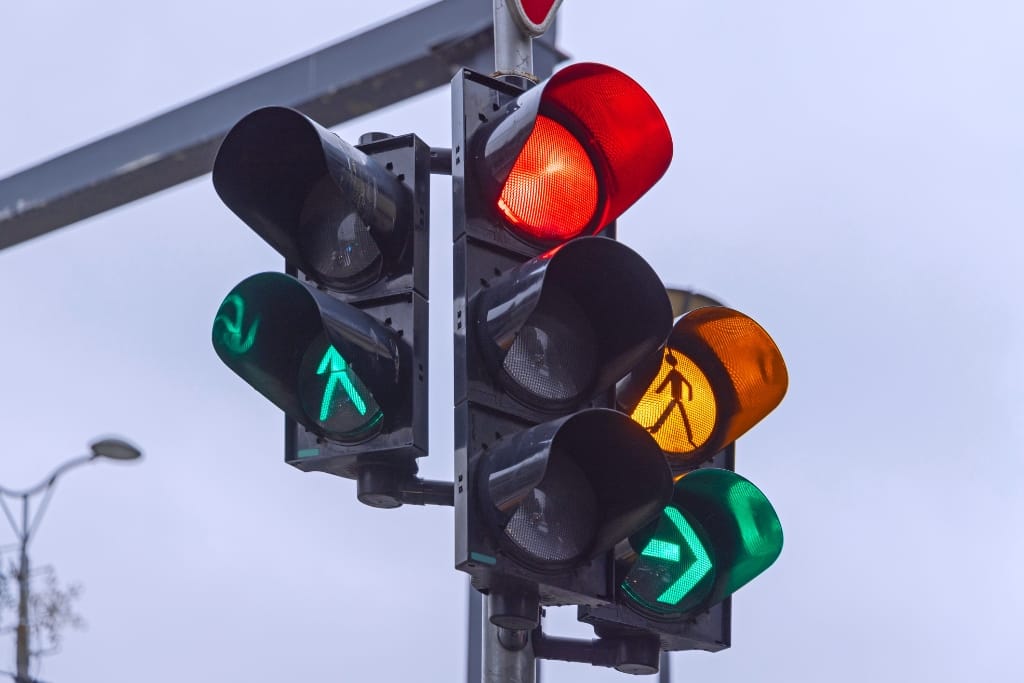Navigating the complexities of traffic laws can sometimes lead to unexpected situations, such as accidentally running a red light.
This common yet serious infraction can have varied implications on your driving record, insurance rates, and even your legal standing.
It's crucial to understand not only the immediate consequences but also the steps you can take afterward to address the situation effectively.
Keep reading to uncover important insights and practical advice that can help you manage the aftermath of running a red light and make informed decisions moving forward.
1)) Understanding Traffic Laws And Penalties
Traffic laws are designed to maintain order and safety on the roads, and understanding your local traffic regulations is essential for every driver.
Running a red light is considered a moving violation and can result in significant penalties, including fines, points on your license, and increased insurance premiums.
In some jurisdictions, multiple violations can even lead to license suspension or mandatory traffic school attendance.
It's important to recognize that these laws vary from state to state, so being aware of specific local statutes can help you avoid unintentional infractions.
Staying informed about the rules and potential penalties ensures that you are better equipped to navigate the roads responsibly.
Understanding traffic laws and their consequences is a fundamental part of being a conscientious driver.
2)) Immediate Consequences Of Running A Red Light
The immediate consequences of running a red light can be both financial and legal, impacting various aspects of your life.
One of the first repercussions you may face is receiving a citation from a law enforcement officer, which typically includes a hefty fine that must be paid within a stipulated timeframe.
Additionally, such an infraction often results in points being added to your driving record, which could lead to increased insurance premiums, as insurers perceive you as a higher-risk driver.
In more severe cases, particularly if the incident resulted in an accident, you might be subject to civil or criminal charges.
These outcomes emphasize the importance of adhering to traffic signals and maintaining vigilance at intersections to prevent these consequences from affecting your driving record and finances.
Being aware of the immediate repercussions underscores the necessity of caution and attention when approaching traffic signals.
3)) How Red Light Cameras Work
Red light cameras are strategically installed at intersections to detect and deter motorists from running red lights.
These cameras function by using sensors that are usually embedded in the road at the stop line.
When a vehicle crosses this line after the light has turned red, the sensors activate the camera, capturing both a photograph and video footage of the violation.
This evidence typically includes the date, time, location, and, in many cases, the speed of the vehicle.
The captured images allow traffic authorities to issue citations to the registered owner of the vehicle involved.
Red light cameras have been instrumental in enhancing intersection safety by reducing the number of violations and potential accidents.
Understanding how these systems operate can encourage adherence to traffic signals and prevent unnecessary violations.
4)) Impact On Your Driving Record
Accumulating violations like running a red light can have significant and long-lasting effects on your driving record.
When you receive a citation for a traffic violation, points are typically added to your driving history, contributing to a negative record that might portray you as an irresponsible driver.
Consistently accruing points can eventually lead to more severe penalties, such as increased insurance premiums or the suspension of your driver's license.
Furthermore, a tarnished driving record may affect your ability to secure safe driving discounts or lower rates from insurance companies, impacting your financial standing.
It's essential to maintain a clean record to avoid these repercussions and ensure a more favorable assessment from insurers and law enforcement alike.
Being mindful of how these violations influence your driving record can motivate more careful driving habits and adherence to traffic laws.
5)) Insurance Implications
Receiving a citation for running a red light can have profound implications on your auto insurance, as insurance companies use your driving record to assess risk and determine premiums.
When you commit a violation like running a red light, it often results in points being added to your license, which insurers interpret as an increased likelihood of future claims.
Consequently, you may see a noticeable rise in your insurance premiums, reflecting your perceived risk as a driver with a history of violations.
This financial strain can persist for several years, as some insurance companies may reevaluate your rates only after a sustained period of safe driving.
Having traffic violations on your record can diminish your eligibility for discounts or benefits that insurers offer to drivers with clean records.
Being aware of the insurance implications of traffic violations underscores the importance of driving responsibly to maintain competitive and affordable insurance rates.
6)) Legal Options And Appeals
If you have received a citation for running a red light, understanding your legal options and avenues for appeals is crucial.
Contesting a traffic ticket often begins with reviewing the evidence against you, such as the photographs or video footage captured by a red light camera.
In some cases, errors in the ticket, such as incorrect vehicle information or extenuating circumstances that justified your actions, can form the basis of a defense.
Legal representation might assist you in negotiating a reduction in fines or even dismissal of charges, especially if the citation negatively impacts your driving record or insurance rates.
The process of appealing a traffic ticket can be time-consuming and may require attendance at court hearings; however, successfully contesting a ticket can mitigate the negative repercussions on your driving record and finances.
Exploring your legal rights and the possibility of appeal highlights the necessity for due diligence and informed decision-making when dealing with traffic violations.
7)) Potential For License Suspension
Receiving multiple traffic violations can ultimately result in the suspension of your driver's license, a severe consequence that underscores the importance of cautious driving.
License suspension is typically triggered by the accumulation of points on your driving record, which are assigned for violations like running red lights.
The specific threshold for suspension varies by jurisdiction, but reaching it can severely impact your daily life by limiting your ability to legally operate a vehicle.
Without a valid driver's license, commonplace activities such as commuting to work, running errands, or completing family responsibilities become challenging, potentially affecting your employment and personal responsibilities.
A suspended license can lead to further legal complications if you continue to drive.
Understanding the potential for license suspension highlights the critical need to adhere to traffic laws and the importance of resolving any citations promptly to prevent escalation.
8)) Tips For Preventing Future Violations
Implementing strategies to prevent future traffic violations is key to maintaining a clean driving record and avoiding potential legal or financial consequences.
One of the most effective methods is developing an increased awareness of traffic signs and signals, as well as understanding the rules specific to each type of roadway or intersection you encounter.
Ensuring that you are well-rested and free of distractions while driving can significantly reduce the potential for mistakes or impulse decisions that could lead to violations.
Practicing defensive driving techniques, such as maintaining safe distances and anticipating the actions of other drivers, can further minimize the risk of incidents.
Enrolling in a defensive driving course not only reinforces these skills but may also offer insurance discounts as an additional benefit.
Being proactive about your driving habits is essential in fostering a safer driving environment for yourself and others, reducing the likelihood of future infractions, and preserving your driving privileges.
9)) Impact On Pedestrian And Driver Safety
The act of running a red light not only jeopardizes the driver's safety but also poses significant risks to pedestrians and other road users.
When a driver chooses to ignore a traffic signal, it can lead to potentially catastrophic collisions at intersections, where multiple streams of traffic converge.
These intersections often involve pedestrians, cyclists, and other vehicles, each vulnerable to the consequences of a driver's reckless behavior.
The unpredictability of such actions makes it difficult for other drivers and pedestrians to anticipate potential hazards, thereby elevating the risk of serious injuries or fatalities.
These incidents contribute to an atmosphere of distrust and fear on the roads, where all parties must remain hyper-vigilant to avoid becoming victims of another’s negligence.
Understanding the severe repercussions on both pedestrian and driver safety underscores the vital importance of obeying traffic laws and signals, which serve as crucial safeguards for everyone on the road.
10)) Importance Of Defensive Driving Techniques
Defensive driving techniques are essential for enhancing road safety by equipping drivers with the skills needed to anticipate and respond to potential hazards.
These techniques emphasize awareness, predicting the actions of other drivers, and making informed decisions to minimize risk.
Defensive drivers maintain a safe following distance, adhere to speed limits, scan ahead for any changes in traffic patterns, and constantly adjust to the road conditions.
Importantly, they also account for adverse weather, construction zones, and the unpredictability of other road users, including pedestrians and cyclists.
By ensuring that these practices are a routine part of driving, individuals not only protect themselves but also contribute to a safer environment for everyone on the road.
Recognizing the importance of defensive driving is key to reducing accidents and enhancing overall traffic safety, underscoring the need for education and mindfulness while behind the wheel.
Conclusion
Fostering a culture of road safety requires diligent adherence to traffic laws and the application of defensive driving techniques to protect all road users.
It is essential to recognize the severity of actions such as running red lights, as these violations can lead to dire consequences for both drivers and pedestrians.
By proactively working to prevent such infractions, individuals can significantly reduce accident risks and ensure safer roads for everyone.
Staying vigilant and continually educating oneself plays a crucial role in nurturing responsibility behind the wheel.
For drivers facing penalties like a red-light camera ticket, seeking the expertise of a specialized lawyer can be a valuable step.
A red light camera ticket lawyer can provide guidance through the legal process, potentially mitigating the repercussions of the citation.
This combined approach of personal responsibility and professional support helps not only to preserve individual driving records but also to contribute to a safer, more trustworthy traffic environment.
Download Our Free E-book!








